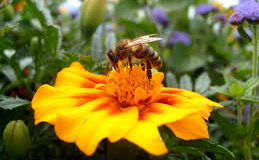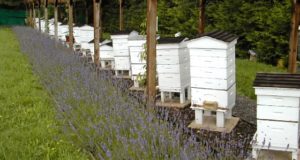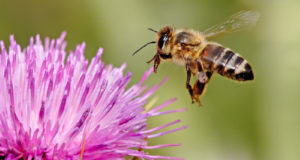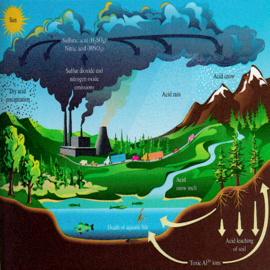
Sustainable Site Development
Sustainable site development has the goal of preserving or restoring a site’s natural ecosystem. The most widely recognized definition of sustainable development is development that “meets the needs of the present without compromising the ability of future generations to meet their own needs.”[1] Sustainability Starts with the Soil
Soil is the soul of project
Soil is the soul of a project. Today, when a construction project begins, first the vegetation is removed. Clear-cutting the trees. Removing any obstructions so the construction equipment can freely traverse the site. If the timber cannot be sold off as lumber (and usually the timber cannot be sold as lumber) the wood is burned onsite or chipped into mulch.
After clearing out the construction traffic obstructions, the topsoil is scraped off. Removing most if not all the rich soil and micro organisms. The soil’s fertility, permeability, and ability to sustain life has been irrevocably transformed into a barren desert. The remaining hard-panned, encrusted soil resembles a track of land with the texture of a poorly compacted piece of asphalt.
When the construction project is complete, new topsoil has to be trucked in for any chance for plant survival. And forget about any wildlife. They have abandoned the site, gone for the hills, literally moved to higher, less inhabited, ground.
Protecting and preserving the soil through minimal site development practices is the starting point for sustainable site development. Restoring an existing site’s soil to a native, natural condition is imperative and the benefits are extraordinary.
Water is the life-blood of the environment
Water is the life-blood in the environment. Water in the environment is the connecting force that ties the environment together. In a natural, forested environment, seventy to ninety percent of the rain fall stays on site. Less than one percent runs off the site.
In nature’s hydrologic (water) cycle, in a naturally, forested area, forty to fifty percent of the rain fall is returned to the atmosphere as water vapor by evaporation and transpiration. Twenty to thirty percent of the rain fall enters streams and waterways after being cleansed by the soil through the soil interflow. The soil interflow is the lateral movement of water through the upper levels of the soil. The remaining ten to forty percent of the water percolates down through the soil in the aquifer.
Today, we rapidly collect the rain water and pipe it into our streams and waterways. This rapidly collected rain water carries debris and pollution from our roofs, parking lots, and roadways. Additionally, in many communities throughout the nation, storm water is combined with waste water and treated as waste water. When communities combine storm water systems with waste water systems the result often is the overflow of raw sewage into the local streams and waterways. Storm water is the single largest source of non-point source water pollution. There has to be a better way!
The result from a low impact site is a dramatic reduction in storm water runoff, resulting a dramatic reduction or elimination of non-point source pollution.
Local pollutants stay local. Stream sedimentation is almost completely avoided. The local aquifer is replenished. Plant Trees
Trees are the spirit in the woods
Simply, plant trees. Trees are the spirit in the world. The environmental benefits of trees are without limit and almost unappreciated. The lack of nature in our environment is creating a “nature deficit disorder.” Richard Louv in his book, Last Child in the Woods, says,”Unlike television, nature does not steal time, it amplifies it.” Powerful experience with nature can have a positive influence on attention deficit disorder, reduce depression, reduce stress, and improve creativity. The need to plant trees is largely unrecognized in our communities and the need has never been greater.
The EPA reports that tree planting sequesters carbon and enhance the quality of soil, water, air and wildlife. If every family planted just one tree, the amount of CO2 in the atmosphere would be reduced by one billion pounds annually. One tree will absorb about ten pounds of air pollutants, including four pounds of ozone. Trees planted around a home can reduce air conditioning usage by 30%. Over a fifty-year lifetime, a tree generates $31,250 worth of oxygen, provides $62,000 worth of air pollution control, recycles $37,500 worth of water, and controls $31,250 worth of soil erosion.[2]
On a larger scale, one acre of new forest will sequester about five thousand pounds of carbon annually. Each year a tree will assimilate thirteen pounds of CO2.
Trees reach their most productive stage of carbon storage at about ten years.
The benefits of trees go far beyond carbon sequestration and energy savings. Trees restore the natural balance of nature. People are more satisfied; communities are more productive; biodiversity increases. Tools for Sustainable Site Development
Since the turn of the last century, little has been done to improve our gray infrastructure. In 2009, the American Society of Civil Engineers (ASCE) graded our drinking water and waste water infrastructures a “D” minus, the lowest grades in any infrastructure category. The next lowest grade is “F” failure. Technology has improved dramatically. Thinking has not. Though we might not always hear about it, sustainable development (and all the interrelated issues associated with it) is an urgent issue.
Green roofs, rainwater harvesting, condensate recovery, permeable paving, rain gardens, bioswales, and daylighting streams are effective tools for changing our world; enhancing our environment. Political will has been slow-paced at best. Much has been written about this. Little has been done.
For example, there are:
- 1.3 Billion people are without access to clean water (it only takes twenty liters of water per person per day to remedy this).
- About half of humanity lacks access to adequate sanitation. Half of humanity lives on less than two dollars a day.
- Approximately 2 billion people are without access to electricity.
And this is in an age of immense wealth which is being concentrated in increasingly fewer hands. The inequality of consumption (and therefore, use of resources, which affects the environment) is terribly skewed: “20% of the world’s people in the highest-income countries account for 86% of total private consumption expenditures – the poorest 20% a minuscule 1.3%” according to the 1998 United Nations Human Development Report.[3]
Green water infrastructure is an approach to water management that protects or restores the natural water cycle. Green infrastructure means restoring floodplains, developing wetlands, planting trees and restoring nature, instead of building new water treatment plants and concentrating stormwater runoff.
Green water infrastructure incorporates both the natural environment and new technology to provide clean water, restore the ecosystem, and provide benefits to people and wildlife. Green water infrastructure boosts the economy, enhances communities’ health, and creates biodiversity. Thinking for Sustainable Development
So far, most sustainable water resource development has occurred outside the United States. However, Green Water Infrastructure stands at the forefront of domestic sustainability development through projects that use green roofs, rainwater harvesting, condensate recovery, permeable paving, rain gardens, and bioswales.
————-
[1] United Nations. 1987.”Report of the World Commission on Environment and Development.” General Assembly Resolution 42/187, 11 December 1987. [2] Colorado Tree Coalition. “Benefits of Trees in Urban Areas.” [3] Source: United Nations Human Development Report, “Changing today’s consumption patterns-for tomorrow’s human development, 1998
Source by Tom Barrett
 Vitamin Agent The Health & Naturalistic Source
Vitamin Agent The Health & Naturalistic Source





